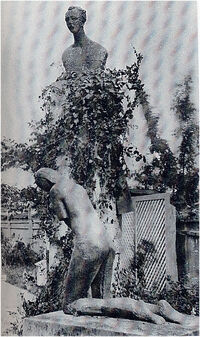Dumbrava Cemetery is the main cemetery of the city of Buzău in Romania.
Main features[]
The cemetery was established on October 20, 1872.
The most important monuments of the cemetery are those of the main landowners in Buzău County in the years preceding the communist takeover of Romania. Among those:
- the tomb of the Seceleanu family, built by Dumitru Seceleanu, one the the biggest landowners of the county. The monument was built by sculptor Frederic Storck
- the monument of the Zangopol family
- the monument of the Covăceanu family, built by Gheorghe Covăceanu, president of the Buzău Chamber of Commerce and Industry.
Among the local personalities buried in the cemetery are:
- Stan Săraru, mayor of Buzău (1933-1937)
- Nicu Constantinescu, mayor of Buzău
- Petre Zangopol, businessman
- Ghiţă Dăscălescu, pitar
- Mihaela Runceanu, artist
- Leon Leonida, businessman, founder of the Romanian Automobile Club, the biggest importer of automobiles in Romania.
Stories of the cemetery[]

Funeral monument of Petre Stănescu by Constantin Brâncuşi
The Brancusi monument[]
In the early 1900s Eliza Seceleanu, daughter of rich landowner Nicolae Seceleanu, fell in love with Petre Stănescu a young lawyer having no fortune. As her father was this relationship, Eliza retired to a monastery, threatening her father that she would take the vows if he did not approve her marriage. Nicolae Seceleanu saw himself forced to give in and in 1905 the young couple was married. Unfortunately, Petre Stănescu, age 31, died only 5 months after the wedding. Eliza requested sculptor Frederic Storck to build the monument of the cemetery. As he had other assignments, Storck recommended Constantin Brâncuşi for the project. Brâncuşi designed a statue known as "The prayer" representing a young woman kneeling in front of a bust of Petre Stănescu. The original, which was completed in 1914, was sold to the National Art Museum of Romania by Eliza, who in the meantime had remarried and now was called Eliza Popovici-Stănescu. In accordance with the sales agreement, the originals were moved to the National Art Museum in Bucharest. The museum also replaced the original withA bronze replica which was installed in the Dumbrava Cemetery, remaining Eliza's property. Eliza Popovici-Stănescu died on July 6, 1970 and the monument was inherited by her children Liliana Teodorescu and Nicoară Popovici-Seceleanu.
In 1994, the sculpture of the cemetery was stolen and was found after two years in a lumber yard of Bistriţa. It was reinstalled but stolen again in 2005 and never found.

Funeral monument of the woman with six children in the Dumbrava Cemetery
The monument of the woman with six children[]
A strange monument represents a sculpture of a woman with six children. An unusual feature for a cemetery is that the sculpture is painted in bright colors. According to a legend, it is the tomb of a woman, wife of an Italian entrepreneur, whose children died on a Christmas eve, having eaten poisoned mushrooms. Another legend states that each of the woman's children died a short time after their birth without anybody being able to determine the cause. Her husband commissioned the statue before leaving the country. The tomb was sold but when the new owner wanted to remove the statue, sounds of a child crying were heard from tomb. After several attempts the new owners renounced in their attempts.
References[]
- Cristian Ionescu - Istorii şi legende îngropate în Cimitirul Dumbrava - Opinia Buzău, 3 Aug. 2011
- Dacă pierdem şi Rugăciunea, oare ce ne mai rămâne?